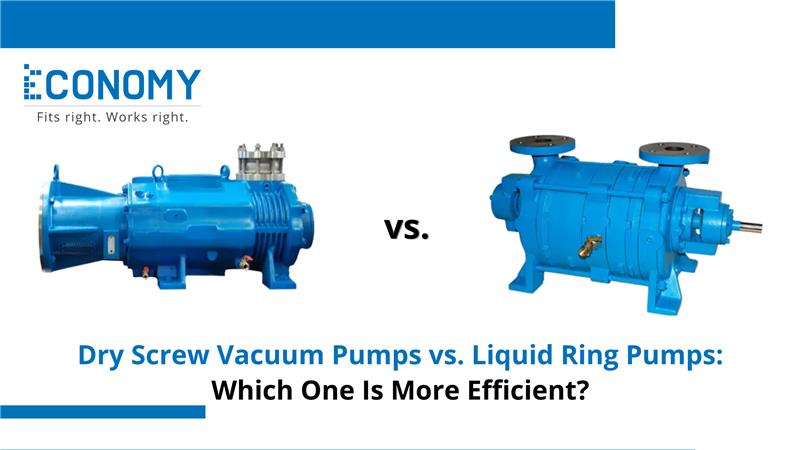Vacuum pumps are essential components across many industries—from pharmaceuticals to power generation. Among the most widely used types are dry screw vs. liquid ring vacuum pumps. Though both serve the core purpose of creating vacuum, their working principles, performance characteristics, and operational efficiencies differ significantly. Choosing the right one can impact everything from process reliability to energy consumption and maintenance costs.
Importance of Making the Right Choice
Selecting a vacuum pump isn’t just about initial cost—it’s about the long-term impact on your entire operation. A poorly matched pump may consume excessive power, fail under specific operating conditions, or require frequent maintenance, leading to production delays and increased costs. The right choice, on the other hand, ensures process stability, energy efficiency, and minimal downtime.
To make an informed decision, users must consider factors like vacuum level requirements, process gases, moisture content, temperature, and cleanliness needs. This is where understanding the core differences between dry screw and liquid ring pumps becomes vital.
Dry Screw Pumps – What You Should Know
Dry screw vacuum pumps operate on a contact-free principle. Inside the pump, two intermeshing screw rotors rotate in opposite directions, compressing and moving gas toward the discharge. Since there’s no liquid or oil in the compression chamber, these pumps are called “dry.”
Key features of dry screw pumps include:
-
Clean, oil-free operation: Ideal for sensitive processes like pharmaceutical production and electronics manufacturing.
-
High vacuum performance: Capable of reaching deeper vacuum levels efficiently.
-
No cross-contamination risk: With no internal lubricants, process gases remain uncontaminated.
-
Corrosion-resistant variants: Suitable for handling aggressive or reactive gases.
-
Energy-smart design: Many models feature variable speed drives to optimize power usage.
While they require higher initial investment, their long-term efficiency and low maintenance needs often justify the cost, especially in clean or controlled applications.
Comparison of Dry Screw Vs. Liquid Ring Vacuum Pumps
Liquid Ring Pumps
Liquid ring vacuum pumps use a rotating impeller within a liquid-filled chamber—typically water or oil. As the impeller spins, the liquid forms a moving ring that traps gas between the impeller blades and compresses it.
Benefits:
-
Excellent for wet, saturated gases or vapors
-
Robust and simple construction
-
Handles dirty or particulate-laden streams
-
Self-cooling due to the circulating liquid
However, they also present challenges:
-
Lower energy efficiency at deep vacuums
-
Require constant liquid supply and disposal
-
Prone to contamination of the sealing liquid
-
Higher maintenance in systems where liquid purity is critical
Comparison at a Glance:
| Feature | Dry Screw Pump | Liquid Ring Pump |
|---|---|---|
| Operating Principle | Dry compression via rotors | Compression using rotating liquid |
| Oil/Water Contamination | None (oil-free) | Possible (liquid carries process gas) |
| Maintenance Needs | Low | Medium to High |
| Vacuum Range | Medium to deep vacuum | Best for low to medium vacuum |
| Process Compatibility | Clean, corrosive, or toxic gases | Wet, dirty, or saturated gases |
| Energy Efficiency | High (especially at variable loads) | Lower, especially in continuous-duty operations |
Which is More Efficient in Practice?
In real-world scenarios, dry screw pumps typically outperform liquid ring pumps in energy efficiency, particularly in applications requiring deep vacuum or clean operation. The absence of sealing liquid eliminates thermal and fluid management losses. Plus, modern screw pumps are often equipped with smart control systems that adjust speed and power according to demand.
However, in processes with high moisture content—such as vacuum distillation of water-based solutions or vapor recovery—liquid ring pumps can be more stable and forgiving, even though they consume more energy. Their simplicity and ability to handle slugs of liquid without damage make them ideal for rugged operations.
So, efficiency is not only about energy—it also includes uptime, process reliability, and maintenance costs. A dry screw pump may use less electricity, but a liquid ring pump might survive harsher conditions longer with less precision tuning.
Which Industries Use These Pumps and Why
Each type of vacuum pump has carved a niche in different industrial segments based on process needs.
Industries Using Dry Screw Pumps:
-
Pharmaceuticals: Require sterile, oil-free environments for API manufacturing.
-
Semiconductors: Need ultra-clean vacuums for wafer fabrication.
-
Chemical Processing: Handle corrosive or reactive gases without contaminating the product.
-
Food Packaging & Freeze Drying: Maintain hygiene and product purity.
Industries Using Liquid Ring Pumps:
-
Pulp and Paper: Handle moist vapors in dewatering systems.
-
Oil & Gas: Used in vapor recovery, flare gas handling, and explosive environments.
-
Textile & Tanneries: Deal with water vapor and fibrous materials.
-
Power Generation: Common in turbine condenser evacuation systems.
Choosing a Pump That Fits Your Operation
To choose the right pump:
-
Evaluate your process gas: Is it dry, corrosive, or laden with moisture?
-
Determine vacuum level requirements: Do you need medium vacuum or deep vacuum?
-
Consider environmental regulations: Oil-free systems may help meet emissions standards.
-
Factor in maintenance access and resources: Will frequent fluid replacement be a burden?
-
Think long-term: Initial cost vs. energy and service savings.
For operations focused on cleanliness, energy savings, and long-term ROI, dry screw pumps are often the better choice. For wet, rugged, or lower-cost installations, liquid ring pumps remain reliable workhorses.
Conclusion
The question of efficiency isn’t about declaring a winner—it’s about matching technology to application. Dry screw pumps lead in energy performance and cleanliness, while liquid ring pumps excel in wet, demanding conditions. Evaluating your operational needs and future goals will help you invest wisely in the vacuum system that delivers the most value over time.







